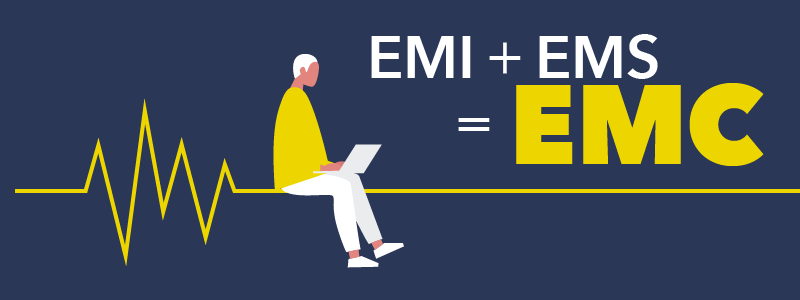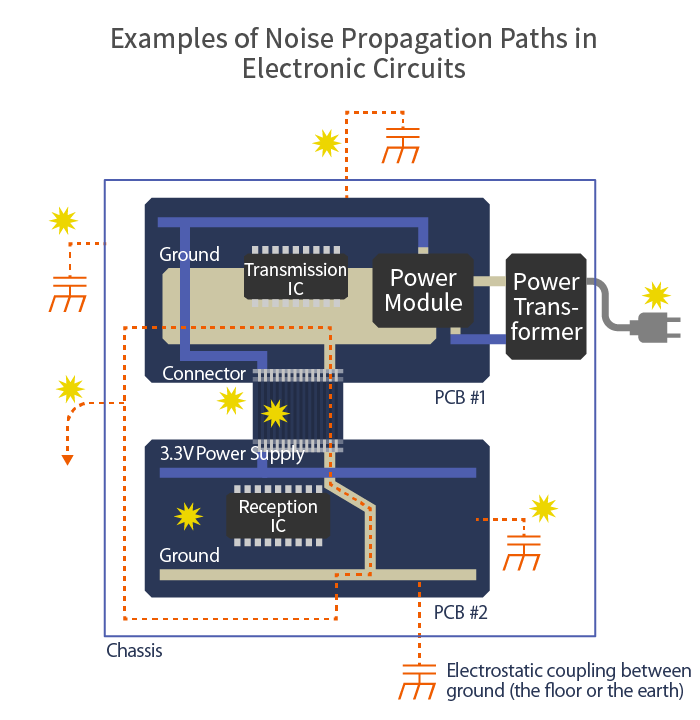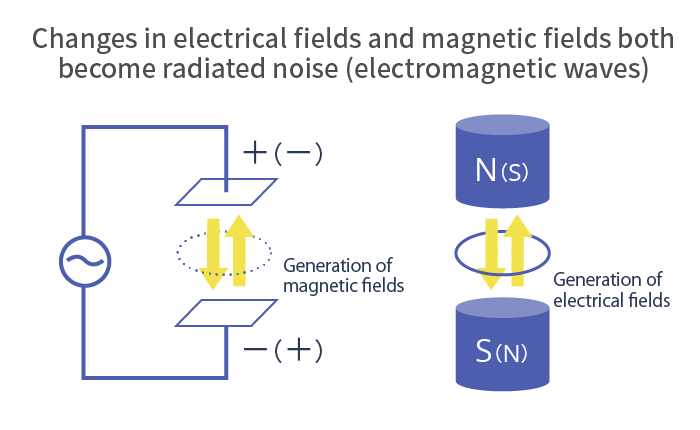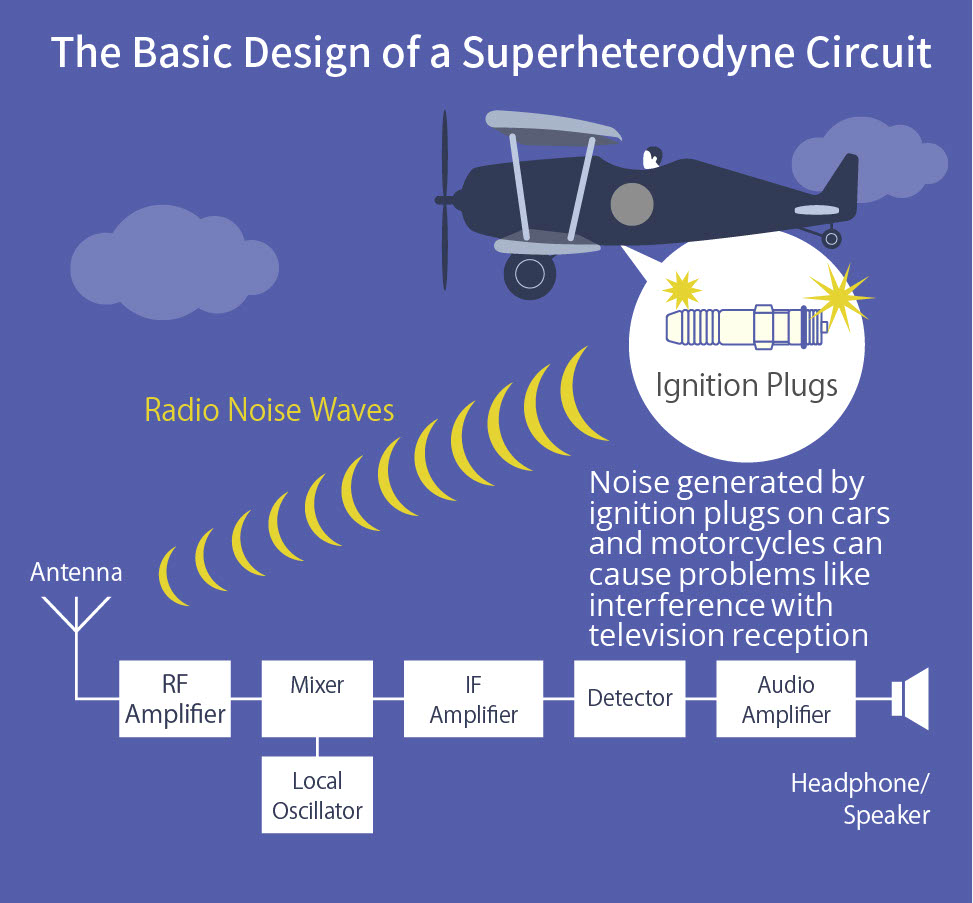Intro to EMC Topics
The Basics—Part 2: Tracing the Invisible—The Roots and Types of Noise

The environment around us is evolving rapidly: cashless payments using smartphones, smart houses optimizing the energy consumption of electrical appliances like heating and lighting, the shift to EVs and autonomous driving technologies, and automated inspection devices and robots empowered with AI image recognition. These technologies depend on the transmission of an enormous amount of electrical signals. Advanced technologies are expected to emerge continually, and the need for high-speed, large-capacity electrical signal transmission will grow in tandem. The security and reliability of these signals are paramount.
Electrical signals and noise are both forms of electromagnetic energy. The more convenient our electronic life becomes, the tighter we need to control noise in our electronic devices.
The two types of noise: conducted noise and radiated noise
To a greater or lesser extent, all electrical and electronic equipment around us is a noise source. Noise, which is invisible to the eye, is similar to heat. It is well known that there are three modes of heat transfer: conduction, convection, and radiation. A typical thermos bottle employs a double-layer vacuum structure to hinder the conduction and convection of heat through air. Radiated heat, however, is an electromagnetic wave (infrared radiation), so a vacuum will not block it. This is why a silver plating is applied to the back of the glass to reflect the infrared rays inward, improving overall heat insulation.
Noise, a form of electromagnetic energy, can be divided into conducted noise and radiated noise, depending on how they are transmitted. Conducted noise is noise that is transmitted along with signals through power supply lines, signal lines and trace patterns on printed circuit boards. Radiated noise is noise that travels through space and arrives as unwanted electromagnetic waves.
Conducted noise has a relatively clear path of intrusion, but it is difficult to identify because it appears similar to signals. In general, electrical signals are transmitted as patterns of voltage change, and noise becomes part of those patterns as it piggybacks on the signals.

Electrostatic coupling between printed circuit boards and ground, as well as electromagnetic coupling between wires, become noise propagation paths. If there is a potential difference between two boards, a large current loop might emerge, becoming yet another noise path. Conducted noise could even transform into radiated noise, and vice-versa.
The inside of a PC is full of unwanted electromagnetic waves
More elusive than conducted noise is radiated noise. Radiated noise surreptitiously finds a way into other electronic devices that are not even connected by cables, and spreads its damage as intra-system noise or even inter-system noise. In circuits where high-frequency currents flow, the wiring’s inductance and other factors generate unwanted electromagnetic waves, turning into noise. Since the amount of electromagnetic radiation increases in proportion to the square of the frequency, personal computers and other devices with clock frequencies in the gigahertz range are major sources of radiated noise.
As mentioned in the preceding article, (1) shielding, (2) reflection, (3) bypassing, and (4) absorption are the four basic methods of noise countermeasures. Housing a PC in a metallic enclosure, for example, is an effort to prevent the leakage of unwanted electromagnetic waves. However, there are numerous openings like CD and DVD doors, vents for releasing internal heat, and gaps between metal plates—all through which waves could leak. Cables connecting peripherals—or even a single loose screw, for that matter—could behave like antennas and emit unwanted waves. Electrical signals and noise are fundamentally the same thing. If they aren’t nipped in the bud, they will get out of hand. Retroactive approaches to suppress noise could actually end up worsening noise problems.
EMC is about suppressing noise generation and preventing noise intrusion in concert
Noise is also magnified by electrostatic coupling and electromagnetic coupling. When there is a conductor, and another conductor nearby through which current is flowing, an invisible capacitor (stray capacitance) is created, and a voltage is induced. This phenomenon is called electrostatic coupling. When a high-frequency current flows, a corresponding voltage change occurs in the conductor, resulting in radiated noise and conducted noise that could adversely affect equipment.
Electromagnetic coupling is an inductive phenomenon caused by a magnetic field. When an AC current flows in a nearby circuit, changes in the magnetic field generated cause a current flow in the nearby circuit. This is based on Faraday’s law of induction—the same principle on which transformers work. The voltages of noise induced by electromagnetic coupling intensify with increased temporal variations of the magnetic field, larger loop areas between circuits, and increased proximity. The reason twisted-pair wires are used to interconnect printed circuit boards is that it reduces the magnetic fields generated by the wires. When wires are twisted in pairs, the magnetic fields generated by the small loops alternate in opposite directions, canceling each other out—resulting in reduced radiated noise.

A change in an electric field generates a magnetic field; a change in a magnetic field generates an electric field

Electromagnetic waves propagate through space by a “chain” of alternating, ring-shaped electric and magnetic fields
In electronic devices with densely integrated circuits, electrostatic and electromagnetic coupling become intensely intertwined, exacerbating the penetration of signals from one line into another. This is called crosstalk (line-to-line coupling). Historically, as electronic devices became smaller, noise problems on circuit boards skyrocketed. Shielded wires are often used to suppress noise, and they are undoubtedly effective against both electrostatic and electromagnetic coupling. It is equally important, however, to first consider the layout of the circuit, such as keeping conductors with large voltage and current fluctuations away from each other, and laying conductors perpendicularly instead of in parallel.
Electronic equipment and noise are inseparable from each other. This is why the concept of EMC, which strives to suppress generated noise as well as prevent noise intrusion, is growing in importance.
TDK is a comprehensive electronic components manufacturer leading the world in magnetic technology







